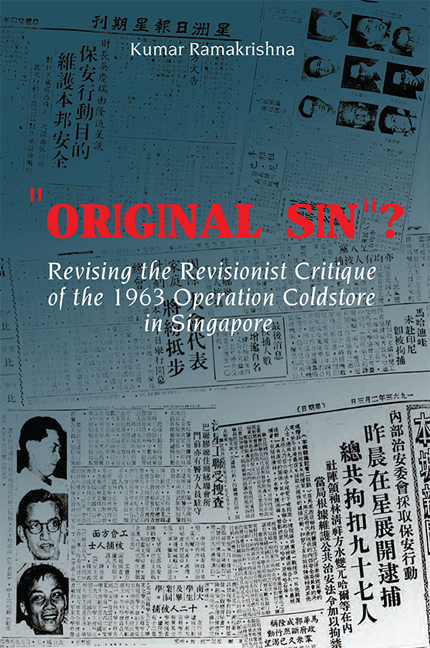Book contents
- Frontmatter
- Contents
- Acknowledgements
- Introduction: The “Alternate” Challenge to the Singapore Story as Context
- 1 Government Sources: Who Uses Them, and the Alternates’ Unarticulated Ideological Outlook
- 2 Was there Really a Dangerous Communist United Front?
- 3 The Curious Case of Lim Chin Siong
- 4 Why “Was Operation Coldstore Driven by Political and Not Security Grounds?” is the Wrong Question
- Conclusion: The Enduring Need for a Singapore Story 2.0
- Bibliography
- Index
- About the Author
Conclusion: The Enduring Need for a Singapore Story 2.0
Published online by Cambridge University Press: 19 May 2017
- Frontmatter
- Contents
- Acknowledgements
- Introduction: The “Alternate” Challenge to the Singapore Story as Context
- 1 Government Sources: Who Uses Them, and the Alternates’ Unarticulated Ideological Outlook
- 2 Was there Really a Dangerous Communist United Front?
- 3 The Curious Case of Lim Chin Siong
- 4 Why “Was Operation Coldstore Driven by Political and Not Security Grounds?” is the Wrong Question
- Conclusion: The Enduring Need for a Singapore Story 2.0
- Bibliography
- Index
- About the Author
Summary
COMMUNISM — THE “GOD” THAT FAILED LIM CHIN SIONG
As seen, in an interview with historian Melanie Chew in 1995, Lim Chin Siong denied being a Communist. This was a prevarication. We now know that privately, on 14 December 1982, Lim had finally admitted to his CPM ties. That day, in an interview with ISD officers, Lim conceded that he had indeed met Fang Chuang Pi @ the Plen as alleged by Lee Kuan Yew in his Battle for Merger radio talks more than twenty years before. Lim added at another meeting with the ISD on 11 January 1984 that he had met the Plen three times between the late 1950s and the early 1960s and these meetings had been initiated by the Plen through a third party. In further interviews later that year, Lim revealed that in 1954, the CPM — through Lim's ABL superior Loo Yeh Shing — had instructed him to join the PAP and make contact with Lee Kuan Yew, “as the latter was planning to form a political party”. This instruction was the genesis of Lim's involvement in politics. Lim Chin Siong, therefore, quite unlike the portrait painted by the Alternates, was no mere left-wing anti-colonial activist who had spontaneously emerged from the teeming, energetic ranks of the anti-colonial Chinese-educated milieu of the tumultuous 1950s. Rather his career in the CUF “appeared to have been planned and charted from the start by the CPM”. Lim's admission of his CPM ties was certainly a long time coming. Following his detention in Coldstore in February 1963, to be sure, he had consistently resisted giving a full account of his past CPM involvement. Even from 1964 onwards, when he had even claimed to have lost faith in global Communism, he revealed nothing. The Special Branch and later ISD assessment was that his “own ideological struggle and his insistence on abiding by his principles, presumably borne out of his reluctance to implicate his comrades and associates”, were reasons as to why he “agonized and vacillated whether to accept Government's terms for release, which included giving a full account of his activities”.
- Type
- Chapter
- Information
- Original Sin?Revising the Revisionist Critique of the 1963 Operation Coldstore in Singapore, pp. 120 - 146Publisher: ISEAS–Yusof Ishak InstitutePrint publication year: 2015



